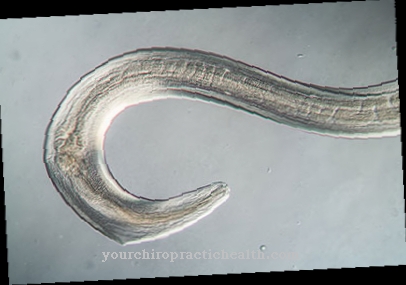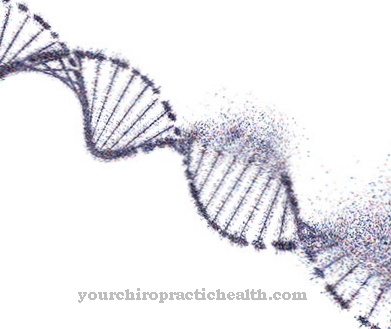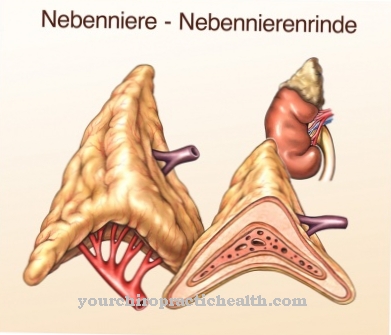The term acute coronary syndrome (short ACS) describes various cardiovascular diseases, which are very similar in their symptoms and therefore not always directly distinguishable. All diseases are caused by an occlusion or narrowing of the coronary arteries.
What are the characteristics of acute coronary syndrome?

The cardiovascular diseases of acute coronary syndrome include unstable angina pectoris, non-transmural and transmural myocardial infarction and sudden cardiac death. In the initial phase, the symptoms of the diseases are very similar and cannot be differentiated with certainty.
This is why the term “acute coronary syndrome” is usually used when there are still unexplained cardiac symptoms that last longer than 20 minutes. 15 percent of the emergency patients with the initial diagnosis of "acute coronary syndrome" have suffered a myocardial infarction, ie a heart attack.
causes
The cause of the diseases of the coronary syndrome is an acute circulatory disorder of the coronary arteries. The coronary arteries, also called coronary vessels, entwine around the heart like a wreath. They arise from the aorta (main artery) and supply the heart muscle with oxygen. If the coronary arteries are narrowed or even blocked, the heart no longer receives sufficient oxygen and can only function to a limited extent or not at all.
In most cases, this is caused by arteriosclerosis, also popularly referred to as hardening of the arteries. In arteriosclerosis, blood lipids, lime, blood clots or blood lipids are deposited in the walls of the arterial vessels. These deposits are also called plaques. Atherosclerosis can develop in all arterial vessels in the body.
If it occurs in the coronary arteries, it is also referred to as coronary artery disease. The consequence of these deposits is a narrowing of the vascular lumen and a loss of vascular elasticity.
Risk factors for developing arteriosclerosis are a high cholesterol level, high blood lipid levels, smoking, diabetes mellitus, high blood pressure and early heart attacks in the family. Obesity and an unhealthy lifestyle with a lot of stress and a high-fat diet also play a role. Environmental pollution such as nocturnal noise or an increased concentration of fine dust in the air should also have an impact on the development of arteriosclerosis.
Symptoms, ailments & signs
If there is a disproportion between the blood flow in the coronary arteries and the acid and nutrient requirements of the heart, angina pectoris occurs. The symptoms often begin during or immediately after exercise. Difficult to digest meals or psychological stress can also trigger angina pectoris.
In unstable angina pectoris, the attacks occur even when the patient is at rest. Angina pectoris manifests itself in severe and burning pain, which is mostly localized behind the breastbone. The pain can also radiate to the left shoulder, left upper arm, or upper abdomen. Those affected feel a sense of annihilation and suffer from fear of death. The seizures usually last no longer than a quarter of an hour. The use of nitro spray brings immediate improvement.
The myocardial infarction often appears like an attack of angina pectoris at first. The pain is localized in a similar way, but more serious and increases continuously.Even with the administration of nitrospray, the symptoms do not improve or only improve very briefly. People are pale or even cyanotic (blue). The pulse can be slow, fast, or normal. Often it is out of rhythm. Dizziness, nausea, or vomiting can also occur.
Pulmonary edema or shock may occur. But the heart attack does not always show itself in this typical form. In patients with diabetes mellitus, the infarction is often completely painless and only manifests itself as a slight nausea. Women, too, often only complain of nausea or vomiting. An occurrence in the early morning hours is characteristic. Sudden cardiac death is probably the most dramatic form of acute coronary syndrome. Death from heart failure occurs within a few minutes.
Diagnosis & course
The diagnosis of the diseases of the acute coronary syndrome is carried out by means of an EKG. Various laboratory parameters such as myoglobin, troponin or CK-MB also provide information about whether the symptoms are angina pectoris or a heart attack.
Coronary angiography is performed to assess the severity of the coronary artery disease. The interior of the coronary arteries is made visible with the help of a contrast medium. In this way, blockages or constrictions can be diagnosed accurately.
Complications
Coronary syndrome can have acute or chronic complications. Myocardial rupture is a possible acute complication. This creates a tear in the heart muscle. The condition is life threatening. The development of a ventricular septum defect is possible as a consequence of the acute coronary syndrome.
The septum between the chambers of the heart is damaged. This affects the pressure in the body and lungs. An increase in pressure in the pulmonary circulation or a reduced pumping capacity of the heart can be consequences of the ventricular septum defect. A possible acute complication of coronary syndrome is papillary muscle tear.
The heart valves are fixed by the papillary muscles. A rupture of the muscle impairs the function of the affected valve. Acute heart failure can result from this. Inflammation of the pericardium (pericarditis) or hemorrhage in the pericardium (pericardial effusion) are further possible complications of acute coronary syndrome. A dreaded consequence is thromboembolism.
This results in blood clots which, in extreme cases, can trigger a stroke. The most common chronic consequence of coronary syndrome is heart failure. The heart's pumping capacity is reduced. The patient is sometimes considerably restricted in daily life due to shortness of breath.
Arrhythmias can be a complication of acute coronary syndrome. The heart rate can be accelerated (tachycardia) or slowed down (bradycardia). All complications of acute coronary syndrome can occur despite treatment for the disease.
When should you go to the doctor?
Since the acute coronary syndrome is usually a very serious complaint and illness, it must always be examined and treated by a doctor. There will be no spontaneous healing and in the worst case the person affected can die of heart failure or cardiac death. In most cases, pain and pressure are felt in the patient's chest.
If there are any problems with the heart, these must be treated immediately. In emergencies or acute pain, an emergency doctor must be called or a hospital must be visited directly. Immediate treatment is also essential if you have difficulty breathing, fear of death or if you feel sick. In the event of sudden cardiac death, however, no further treatment is possible and the person concerned usually dies.
In acute coronary syndrome, a cardiologist must therefore be consulted. However, if the pain is severe, immediate surgery or resuscitation measures are necessary. This also applies if the person concerned has already lost consciousness.
Doctors & therapists in your area
Treatment & Therapy
Acute angina pectoris is usually done with nitro preparations. This causes the blood vessels in the body to widen, and thus also the coronary arteries. Symptoms quickly improve. A neurostimulator can also be used. A neurostimulator is a small device that is implanted under the skin in the abdomen.
In the event of a seizure, the patient can switch on the neurostimulator. This then sends electrical impulses to the spinal cord. These electrical signals modulate pain. If the symptoms do not go away or fade within a short time, the emergency doctor should be informed in any case, as it could be a heart attack. This requires quick action and intensive medical care. In the hospital, either lysis therapy is carried out to dissolve blood clots that are clogging the arteries or a stent is implanted using a balloon catheter.
Outlook & forecast
Acute coronary syndrome usually leads to various complications of the heart and circulatory system. In many cases, the syndrome cannot be diagnosed directly because there are no clear symptoms or symptoms.
There is usually severe and burning pain in the shoulder or upper arm. Sometimes there is a panic attack or a so-called feeling of death and the person concerned suffers from sweating. In addition, there is severe nausea associated with vomiting. The person concerned looks pale and exhausted and often suffers from disorders of concentration.
In most cases, treatment is acute with the help of drugs. It can quickly limit the symptoms. In long-term treatment, a neurostimulator is used to prevent the patient's death. It can also lead to a heart attack, which can lead to death. The life expectancy of the patient is in most cases limited by the coronary syndrome.
prevention
The primary prevention goal is the reduction of risk factors for acute coronary syndrome. Those affected should increase their physical activity, change their diet and stop smoking. In addition, medical support is usually provided.
In addition, anti-platelet drugs are used. These are designed to prevent blood clots from forming in the arteries. Cholesterol-lowering drugs are also used. This is intended to lower the vascular damaging LDL cholesterol (colloquially “bad cholesterol”) in favor of the vascular protecting HDL cholesterol (colloquially “good cholesterol”).
Aftercare
While the acute coronary syndrome must be treated immediately by medical help, the patient must also be consistently involved in the follow-up care. Because aftercare for this serious clinical picture means minimizing the likelihood of a new flare-up through healthy behavior in everyday life as well as possible. This cooperation of the patient in the context of secondary prevention means a bundle of measures that are tailored to the patient's needs and always discussed with the treating doctor.
This begins with a healthy diet that supports the functions of the blood vessels and the cardiovascular system and can also achieve any necessary weight reduction. Refraining from nicotine and alcohol are important factors in recovery from acute coronary syndrome. A healthy amount of exercise is necessary, especially for overweight patients.
Here too, the heart and circulation are revitalized and weight is built up. In addition, there is a strengthening of the immune system and an associated reduction in susceptibility to infections. The sport in the context of coronary sport groups can be specifically tailored to the problems of the respective patient. General practitioner, internist and cardiologist provide information on groups.
Stress has an adverse effect on acute coronary syndrome. Therefore relaxation procedures are also important helpers in the context of targeted aftercare. Autogenic training, progressive muscle relaxation and yoga are some of the methods that can effectively relieve the patient's psychological tension.
You can do that yourself
In the case of an acute coronary system, those affected can do a lot for the stability of their immune system through a healthy and balanced lifestyle. The stronger your own immune system, the better it can build up defenses against germs or other pathogens. This prevents infectious diseases and shortens the healing process.
With a healthy and varied diet, the organism has sufficient nutrients and messenger substances that are important for recovery. At the same time, physical overexertion or obesity should be avoided. Intense sporting activities or carrying heavy objects increase the stress on the heart. Regular breaks, rest periods and relaxation exercises are helpful, however. Meditation or [[yoga] can improve recovery.
In times of strong emotional challenge or a lot of stress, the person concerned should look for ways to reduce stress. Various coping mechanisms, changing cognitive attitudes or learning new behavioral patterns help to be able to deal better with stressful situations.
In a respectful interaction with other people, one's own limits can be shown or emerging conflicts can be resolved with calm and prudence. Relief of the heart should be the focus of all activities. This must be implemented on the physical as well as the emotional level so that no additional stress arises.













.jpg)

.jpg)
.jpg)











.jpg)